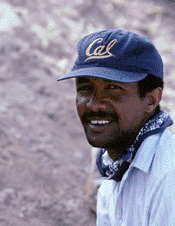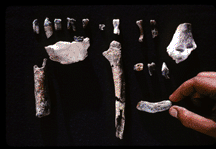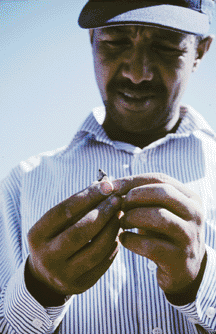 |
|
Yohannes
Haile-Selassie, a doctoral student at the University
of California, Berkeley.
Copyright
1996 Tim D. White \ Brill Atlanta
|
Berkeley
— Scouring the dry washes encircling an Ethiopian site
where scientists seven years ago found fossils of 4.4 million-year-old
human ancestors, University of California, Berkeley, graduate
student Yohannes Haile-Selassie has found even older fossils
that show human ancestors walked on two legs as early as
5.2 million years ago.
The fossils
are the earliest hominid known, and date from close to the
time when human ancestors are believed to have split off
from the chimpanzees on the first steps of their evolutionary
trip to modern Homo sapiens.
The fragmentary
fossils, which include teeth, a jawbone, hand, arm and collar
bones, and one toe bone, appear to be from family members
of the species discovered in 1994 by an international team
led by UC Berkeley paleoanthropologist Tim White. They named
that species Ardipithicus ramidus, and concluded
that it was the earliest known human ancestor. Haile-Selassie,
for now, has designated the new fossils as a subspecies
of this earlier find: Ardipithicus ramidus kadabba.
"Its
dentition is that of a hominid, its toe bone is like that
of a bipedal animal," said Haile-Selassie from Addis Ababa,
where he continues to study the fossils at the National
Museum of Ethiopia. "It's definitely a hominid, and proves
that the earlier 4.4 million-year-old Ardipithecus ramidus
was a hominid, not an ape."
Haile-Selassie
reported his finds in the July 12 issue of Nature.
A second paper in Nature by geologist Giday WoldeGabriel
of Los Alamos National Laboratory, coauthored by Haile-Selassie,
White and others, described the paleoclimate of the area
Ardipithecus roamed nearly 6 million years ago.
The publication
of these two papers by Haile-Selassie and WoldeGabriel,
both Ethiopians, is a major milestone in African paleoanthropology,
according to White, a professor of integrative biology.
"These
two local scholars have joined the international scientific
community at the highest level," said White, a faculty member
in the College of Letters & Science. "This is a huge development
in African paleoanthropology and a welcome change in the
conduct of this science.
 |
|
Hominid
fossils belonging to Ardipithecus ramidus kadabba,
found in 1997-1999. The mandible of the subspecies
is at upper left, the toebone is in the right upper
row, and the hand holds a fragment of collar bone.
Copyright
1999 Tim D. White \ Brill Atlanta
|
"UC Berkeley
has played a major role in this. Beginning with J. Desmond
Clark and Clark Howell, we have had a program for many years
at Berkeley of nurturing and training people from developing
countries to do paleoanthropology. This is an example of
how that has paid off scientifically, for Africa and for
Ethiopia."
Clark
and Howell are professors emeriti of anthropology at UC
Berkeley and among the most respected anthropologists working
in Africa during the past century.
Haile-Selassie
found the new fossils along the western margin of the Afar
rift in the Middle Awash region of Ethiopia, about 140 miles
northeast of the capital Addis Ababa and 25 kilometers from
the Aramis site where White's team found A. ramidus. The
fossils came from sites in four different arroyos draining
the margin and one closer to the Aramis discoveries. These
sites were identified by first surveying the area with satellite
imagery and air photos, then on foot, and finally, after
the areas were determined to be possible fossil sites, with
an intensive survey to establish their age based on fossils
evidence.
"When
you don't find anything, an hour is like a day," Haile-Selassie
said about discovering the first fossil — a mandible
or jawbone with one molar — in 1997. "But
when you find good stuff, you don't even want night to come,
you want to work 24 hours to find more. That's how exciting
it was."
 |
|
Discovery
in 1998 by Yohannes Haile-Selassie of an Ardipithecus
ramidus kadabba canine tooth. This tooth, recovered
while sieving loose sediment at the site, is different
from the canine teeth of all modern and extinct apes.
Instead, it resembles later hominids. Based on his
analysis of this tooth and other fossils, Haile-Selassie
has interpreted these fossils to represent our earliest
ancestor this side of the common ancestor we once
shared with modern chimpanzees. The tooth and other
fossils are dated to 5.7 million years ago.
Copyright
1999 Tim D. White \ Brill Atlanta
|
He subsequently
found at the five sites a total of 11 fragments representing
at least five individuals. Together, he said, these provide
evidence that the chimpanzee-sized creature was not an ape
but an early ancestor of humans.
"These
canine teeth are not of humans, but no chimp has canine
teeth like that either," White said. "This argues that these
fossils are not from the common ancestor of both chimps
and humans, but from very early in our evolution, shortly
after our ancestors parted company and before our canines
fully reduced."
Another
argument that the fossils are from a hominid, not an ape,
is that the toe bone shows a slanted surface at the rear
joint, which is characteristic of bipedal walking. This
is caused by toeing-off — pushing forward by leaving
the front part of the foot on the ground and lifting the
heel. This anatomy is characteristic of A. ramidus
and all later hominids, but not of chimpanzees and other
apes, which walk on the outside of their feet.
The toe
bone "is consistent with an early form of terrestrial bipedality,"
Haile-Selassie concluded in his Nature paper.
His continuing
search for more fossils from the same period should give
a better idea whether the new finds are an early form of
A. ramidus or a species ancestral to it.
Haile-Selassie
also noted that fossils found in Kenya last year and dated
at 6 million years by a team of French paleoanthropologists
are ambiguous, even though the researchers claimed they
are the oldest human ancestor and named the fossil creature
Orrorin tugenensis. Until more bones of this animal
are found and more studies conducted, he said, it is impossible
to say whether Orrorin is the earliest human ancestor,
the earliest chimpanzee, or the common ancestor of both.